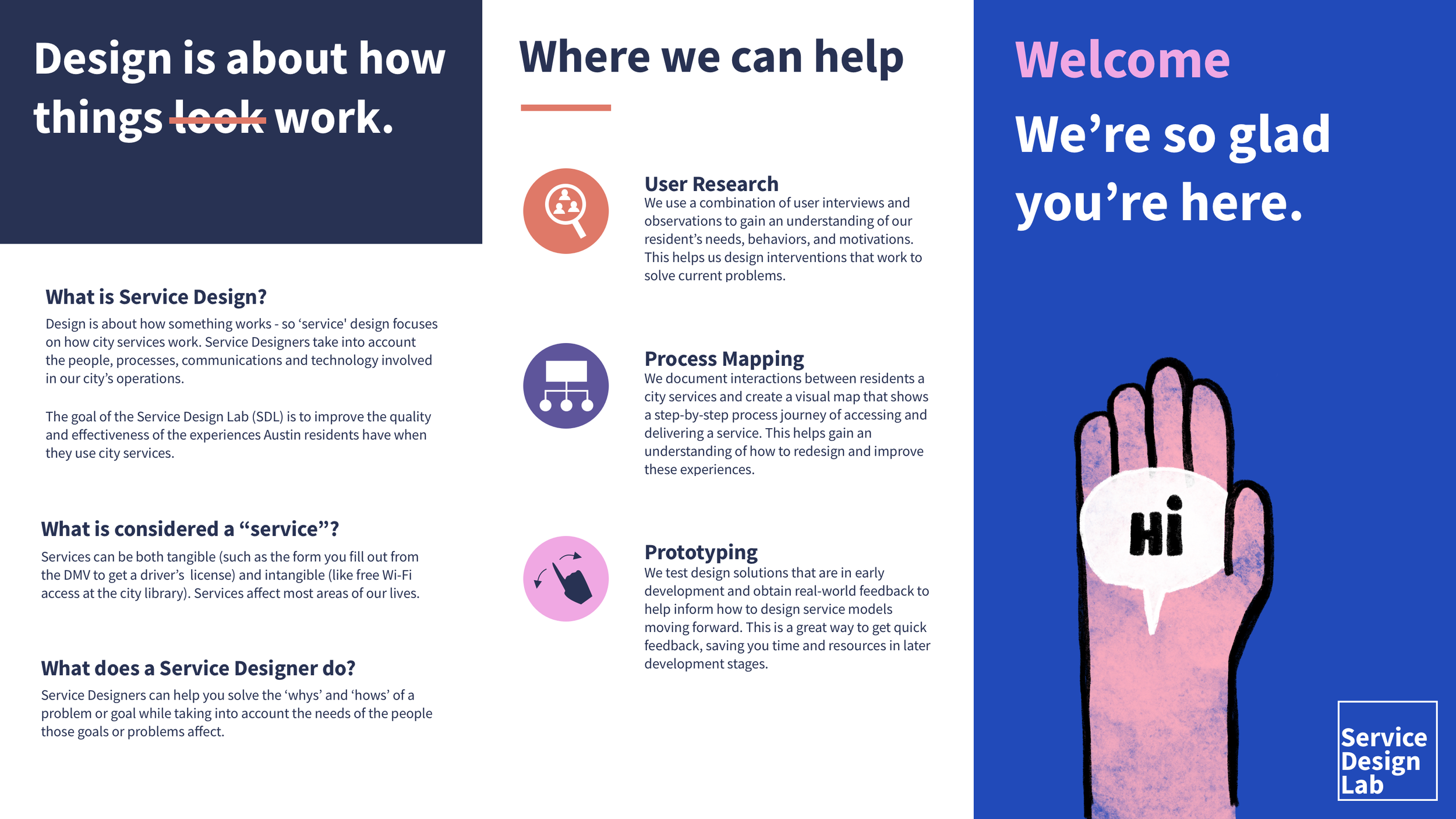Understanding the Service in Service Design
Creating an FAQ and roadmap to illustrate the experience of working with service designers.
City of Austin’s Office of Design and Delivery website
At the City of Austin’s Service Design Lab (SDL), a team of talented UX designers have made improving the delivery of business and residential services their primary goal. Working directly with the city’s department managers, the SDL team has designed solutions to improve a wide array of needs, including streamlining the food truck permitting process, expanding search criteria for available low-income housing and elevating access to services for people experiencing homelessness.
Project Overview
Problem: The designers felt underutilized because the department managers they served didn’t understand what the Service Design Lab offered or how to put their expertise to use.
Challenge: How could the team better explain their mission and illustrate their work process to engage their stakeholders and help set realistic project goals and expectations?
Details
Timeline: 3 months
Design methods: user interviews, workshop facilitation, journey mapping exercises, personas
My roles: content creation and strategy; user research
Design partners: information architect, graphic designer
Research
My team met with SDL’s designers for interviews and a journey mapping workshop. They walked us through the onboarding process and gave us extensive background about their experiences on past projects.
Some discoveries from our workshop included:
“Some clients don’t know what service design is, they don’t realize we’re here to support them.”
“The ‘asks’ from our clients aren’t always clear; there’s a lack of clarity or realistic goals about what to expect.”
“We prepare our first meeting with a client based on information they provide, but often what they described in that initial application doesn’t match with our actual conversation. This causes recalibration in the middle of the meeting and causes stress for our team.”
How could we help inform the city’s department managers about what services designers do?
Facilitating a journey mapping exercise at Austin’s Service Design Lab
User Interviews
To identify opportunities for improvement, we interviewed former clients to understand why they sought SDL’s help, and what the work experiences were like. Participants indicated they didn’t realize the value of working with a service designer, or understand what role a service designer could play, until after the project was well underway.
We also interviewed potential users, screen sharing SDL’s website and onboarding materials and asking users to identify the barriers that would keep them from seeking design services.
The majority of participants indicated their lack of familiarity with the terminology and understanding of what services were being offered were the main reason they wouldn’t seek out SDL’s help.
Design Solution
Create a pamphlet for potential clients that is visually engaging and easy to understand. The pamphlet would be available in both English and Spanish, and in print and digital formats.
Our primary focus was on the language – keeping it short and straightforward were key principals. We decided simple definitions paired with an engaging design were the approach, and I created an FAQ based on the responses from our user interviews.
Finished prototype for FAQ (front of pamphlet)
To address the issues of scope and expectations, we created a journey map that illustrated the client’s journey from the first meeting to the final stage of the project:
Finished prototype for client’s journey map (back of pamphlet)
Reflection
Reviewing these new features with our interview participants was generally successful. All agreed that the new definitions and the addition of a visual aid helped them understand what to expect when working with a service designer. However, our tools did not address two the larger, ongoing issue: how SDL can find and engage with new audiences to bring in new projects; and the lack of time and resources people and departments had to undertake new projects that would bring about change.
End note: The Office of Design and Delivery is now embedded into the larger network of the City of Austin services.




